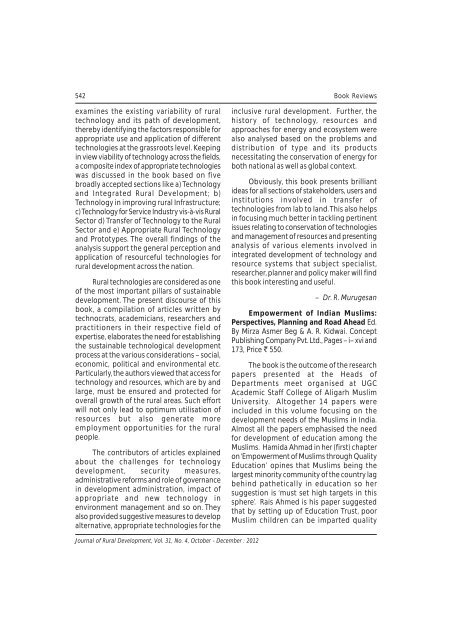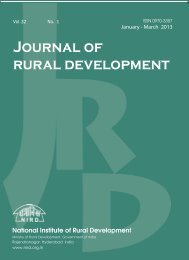October - December 2012 - National Institute of Rural Development
October - December 2012 - National Institute of Rural Development
October - December 2012 - National Institute of Rural Development
- No tags were found...
Create successful ePaper yourself
Turn your PDF publications into a flip-book with our unique Google optimized e-Paper software.
542 Book Reviewsexamines the existing variability <strong>of</strong> ruraltechnology and its path <strong>of</strong> development,thereby identifying the factors responsible forappropriate use and application <strong>of</strong> differenttechnologies at the grassroots level. Keepingin view viability <strong>of</strong> technology across the fields,a composite index <strong>of</strong> appropriate technologieswas discussed in the book based on fivebroadly accepted sections like a) Technologyand Integrated <strong>Rural</strong> <strong>Development</strong>; b)Technology in improving rural Infrastructure;c) Technology for Service Industry vis-à-vis <strong>Rural</strong>Sector d) Transfer <strong>of</strong> Technology to the <strong>Rural</strong>Sector and e) Appropriate <strong>Rural</strong> Technologyand Prototypes. The overall findings <strong>of</strong> theanalysis support the general perception andapplication <strong>of</strong> resourceful technologies forrural development across the nation.<strong>Rural</strong> technologies are considered as one<strong>of</strong> the most important pillars <strong>of</strong> sustainabledevelopment. The present discourse <strong>of</strong> thisbook, a compilation <strong>of</strong> articles written bytechnocrats, academicians, researchers andpractitioners in their respective field <strong>of</strong>expertise, elaborates the need for establishingthe sustainable technological developmentprocess at the various considerations – social,economic, political and environmental etc.Particularly, the authors viewed that access fortechnology and resources, which are by andlarge, must be ensured and protected foroverall growth <strong>of</strong> the rural areas. Such effortwill not only lead to optimum utilisation <strong>of</strong>resources but also generate moreemployment opportunities for the ruralpeople.The contributors <strong>of</strong> articles explainedabout the challenges for technologydevelopment, security measures,administrative reforms and role <strong>of</strong> governancein development administration, impact <strong>of</strong>appropriate and new technology inenvironment management and so on. Theyalso provided suggestive measures to developalternative, appropriate technologies for theinclusive rural development. Further, thehistory <strong>of</strong> technology, resources andapproaches for energy and ecosystem werealso analysed based on the problems anddistribution <strong>of</strong> type and its productsnecessitating the conservation <strong>of</strong> energy forboth national as well as global context.Obviously, this book presents brilliantideas for all sections <strong>of</strong> stakeholders, users andinstitutions involved in transfer <strong>of</strong>technologies from lab to land. This also helpsin focusing much better in tackling pertinentissues relating to conservation <strong>of</strong> technologiesand management <strong>of</strong> resources and presentinganalysis <strong>of</strong> various elements involved inintegrated development <strong>of</strong> technology andresource systems that subject specialist,researcher, planner and policy maker will findthis book interesting and useful.– Dr. R. MurugesanEmpowerment <strong>of</strong> Indian Muslims:Perspectives, Planning and Road Ahead Ed.By Mirza Asmer Beg & A. R. Kidwai. ConceptPublishing Company Pvt. Ltd., Pages – i– xvi and173, Price ` 550.The book is the outcome <strong>of</strong> the researchpapers presented at the Heads <strong>of</strong>Departments meet organised at UGCAcademic Staff College <strong>of</strong> Aligarh MuslimUniversity. Altogether 14 papers wereincluded in this volume focusing on thedevelopment needs <strong>of</strong> the Muslims in India.Almost all the papers emphasised the needfor development <strong>of</strong> education among theMuslims. Hamida Ahmad in her (first) chapteron ‘Empowerment <strong>of</strong> Muslims through QualityEducation’ opines that Muslims being thelargest minority community <strong>of</strong> the country lagbehind pathetically in education so hersuggestion is ‘must set high targets in thissphere’. Rais Ahmed is his paper suggestedthat by setting up <strong>of</strong> Education Trust, poorMuslim children can be imparted qualityJournal <strong>of</strong> <strong>Rural</strong> <strong>Development</strong>, Vol. 31, No. 4, <strong>October</strong> - <strong>December</strong> : <strong>2012</strong>

















